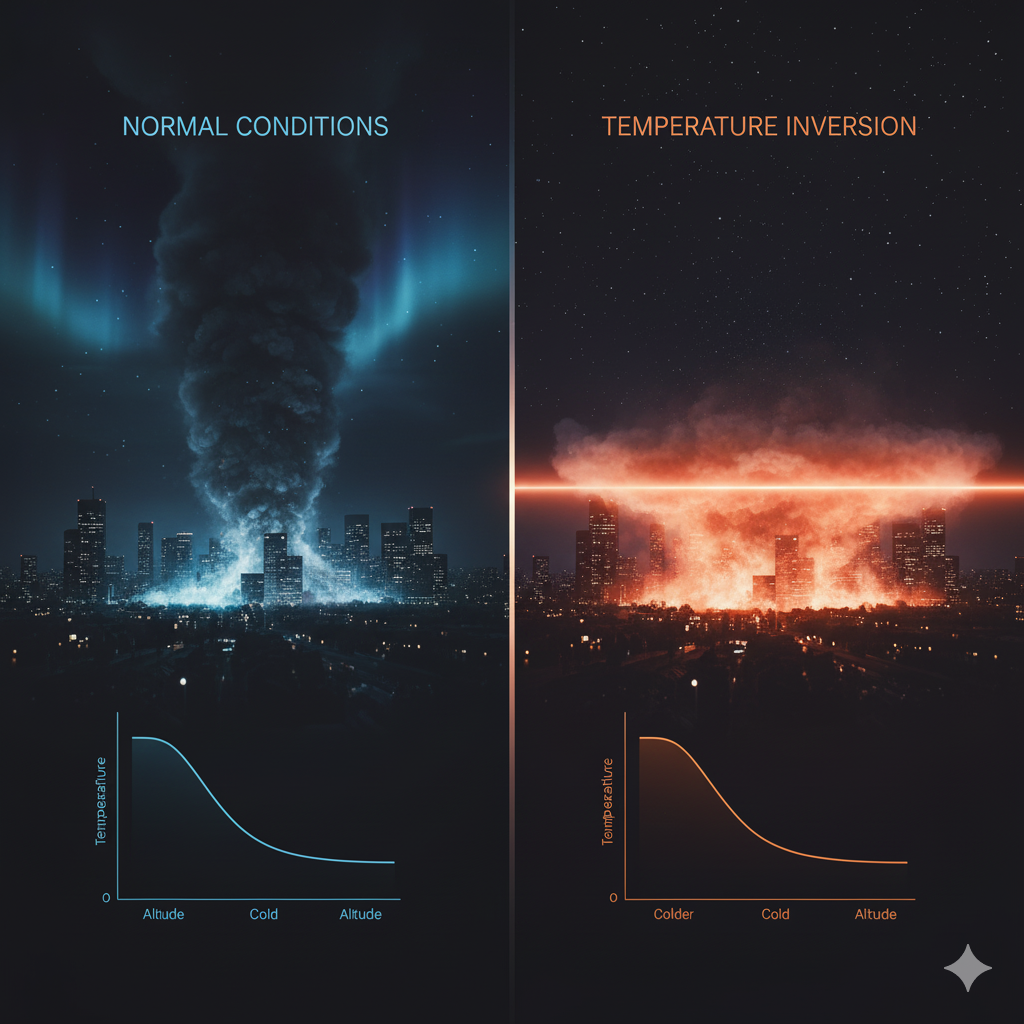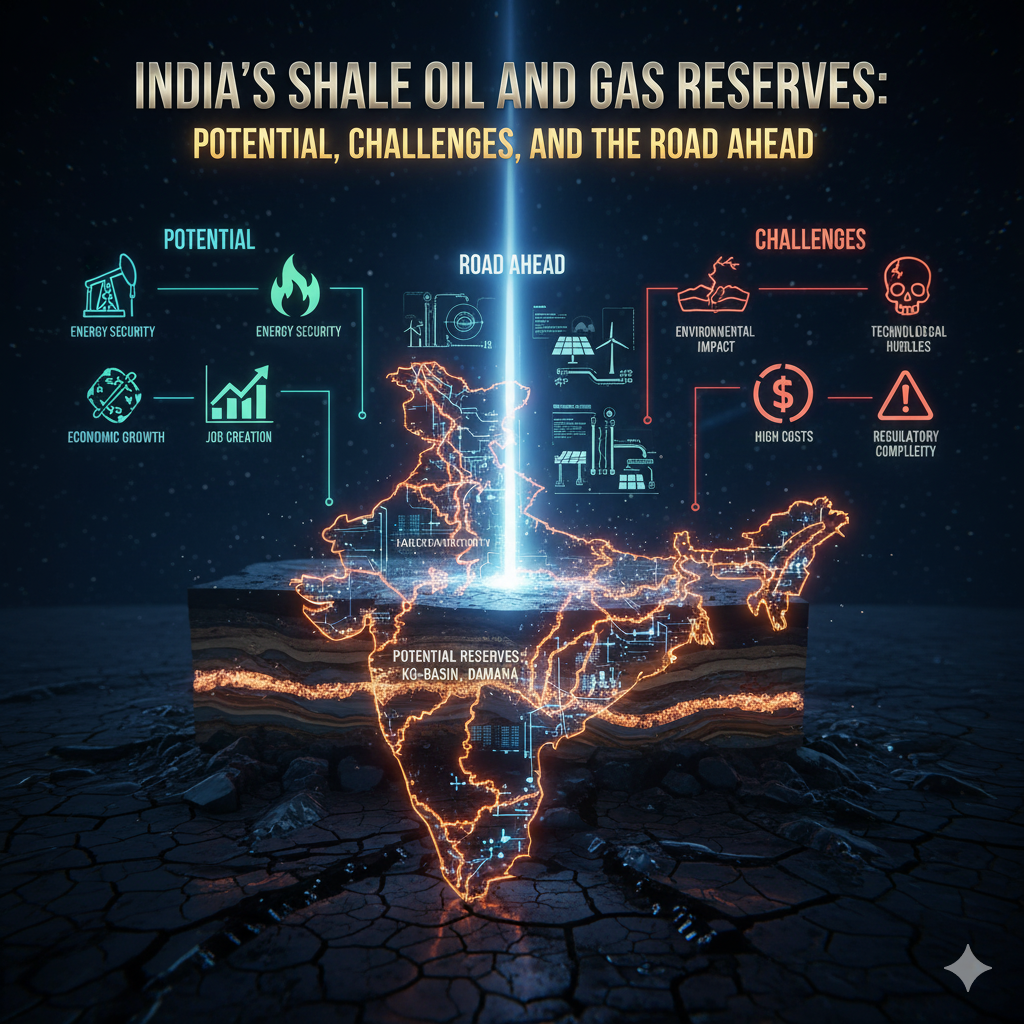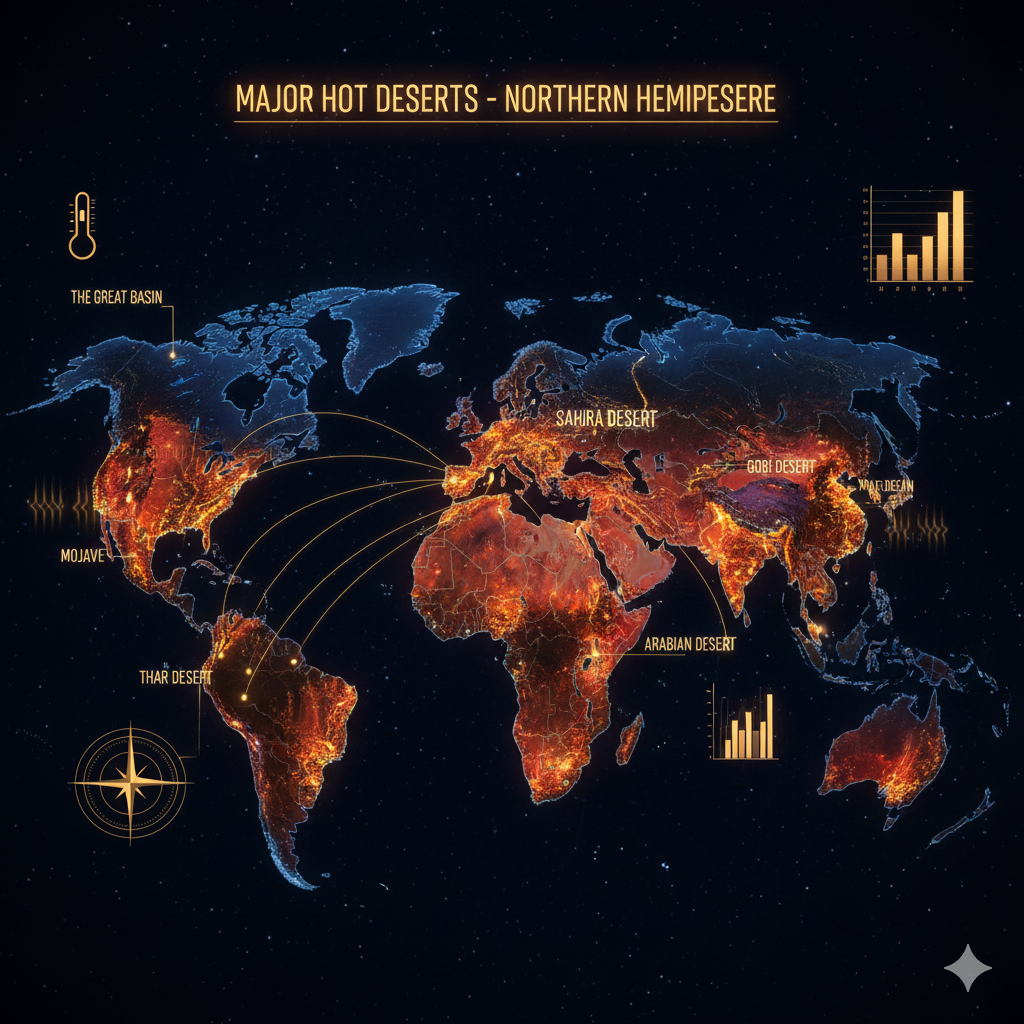Introduction
In the field of meteorology, understanding the vertical distribution of temperature in the atmosphere is essential to explain various weather phenomena. Normally, as altitude increases, air temperature decreases—a process known as the normal lapse rate, averaging around 6.5°C per 1000 meters. However, under certain conditions, this pattern reverses, and the temperature increases with height instead of decreasing. This reversal of the normal temperature gradient is called Temperature Inversion.
The phenomenon of temperature inversion has profound implications for weather conditions, air pollution, cloud formation, and human health. It plays a critical role in the occurrence of smog in urban areas, frost in valleys, and stable atmospheric conditions that suppress rainfall and convection.
This essay explains the concept, causes, types, effects, and consequences of temperature inversion in a detailed and educational manner, highlighting its significance in understanding local and regional climates.
1. Understanding Temperature Inversion
1.1 Definition
Temperature inversion refers to the reversal of the normal temperature gradient in the troposphere, in which temperature increases with altitude instead of decreasing.
In simple terms, during a temperature inversion, a layer of warm air lies above a layer of cooler air, preventing vertical mixing and creating a “lid” over the lower atmosphere.
1.2 Normal Temperature Gradient
Under normal atmospheric conditions:
- Solar radiation heats the Earth’s surface.
- The warm surface transfers heat to the air above it, causing the air near the ground to become warmer and rise (convection).
- As air rises, it expands and cools with altitude.
This results in a decrease of temperature with height, called the lapse rate.
1.3 Reversal during Inversion
In temperature inversion:
- The lower layers of the atmosphere cool rapidly, while the upper layers remain relatively warm.
- As a result, the temperature increases with height, creating a stable layer that resists vertical motion.
This inversion layer acts like a cap, trapping air and pollutants below it.
2. Causes and Mechanisms of Temperature Inversion
Temperature inversion occurs due to a combination of radiative, topographical, and dynamic factors. These processes disturb the normal vertical temperature structure of the troposphere.
2.1 Radiational Cooling of the Earth’s Surface
The most common cause of temperature inversion is nocturnal (nighttime) cooling of the ground.
- After sunset, the Earth loses heat rapidly through terrestrial radiation.
- The air in contact with the surface cools faster than the layers above it.
- This leads to cooler air below and warmer air above—a condition of radiation inversion.
Conditions that favor radiational cooling include:
- Clear skies (allowing more heat to escape).
- Calm winds (preventing air mixing).
- Long nights (allowing prolonged cooling).
This is common in winter nights and high-pressure regions.
2.2 Advection of Warm Air over Cool Surface (Advectional Inversion)
When a warm air mass moves over a cold surface, such as a cold ocean current or snow-covered land, the air near the surface cools while the upper air remains warm.
This results in advectional inversion, often seen along coastal regions, such as:
- The California coast (influence of the cold California Current).
- The Peru–Chile coast (Humboldt Current).
2.3 Subsidence of Air in High Pressure Areas (Subsidence Inversion)
In anticyclonic conditions, air descends slowly due to high pressure.
- As air descends, it gets compressed and warms adiabatically.
- The lower layer, in contact with the ground, remains cooler.
This forms a subsidence inversion, commonly observed in subtropical high-pressure belts (e.g., Sahara, Arabian Peninsula).
2.4 Frontal Inversion
At a weather front, a warm air mass may override a cold air mass.
- The interface between the two air masses creates a sharp temperature contrast.
- The warm air above and cold air below results in frontal inversion.
This is typical of mid-latitude cyclones.
2.5 Valley Inversion
In mountainous and hilly regions, cold air being denser tends to sink into valleys at night, while the hilltops remain warmer.
- This forms a temperature inversion in valleys, especially during clear, calm nights.
- It is a common phenomenon in Himalayan valleys, Alps, and Andes.
2.6 Inversion Due to Urban Heat Island Effect
In cities, the urban heat island (UHI) effect can modify local temperature structures.
- During the day, urban surfaces absorb heat.
- At night, rapid cooling of nearby rural air may lead to temperature inversion between urban and suburban zones, trapping pollutants in the city core.
3. Types of Temperature Inversion
Temperature inversions can be broadly classified based on formation mechanisms and spatial occurrence.
3.1 Radiation Inversion
- Occurs due to rapid cooling of the surface at night.
- Common on clear, calm winter nights.
- Found in valleys and plains.
- Usually disappears after sunrise due to solar heating.
3.2 Advectional Inversion
- Caused by horizontal movement of air (advection).
- Warm air moves over a cold surface, cooling from below.
- Common in coastal and oceanic regions influenced by cold currents.
3.3 Subsidence Inversion
- Occurs in high-pressure zones where air descends and warms.
- Characterized by persistent and strong inversion layers.
- Common in deserts and subtropical regions.
3.4 Frontal Inversion
- Found at weather fronts, where warm air overrides cold air.
- Often associated with clouds, fog, and precipitation.
3.5 Valley Inversion
- Formed by cold air drainage into valleys during nighttime.
- Results in fog, frost, and smog in low-lying regions.
4. Characteristics of Temperature Inversion
- Reversal of Lapse Rate: Temperature increases with altitude instead of decreasing.
- Formation of a Stable Layer: The atmosphere becomes statically stable, restricting vertical air movement.
- Persistence: Radiation inversions last overnight; subsidence inversions may persist for days or weeks.
- Temperature Difference: The inversion layer may have a difference of 2°C–10°C or more between lower and upper layers.
- Visibility Reduction: Trapped pollutants and fog below the inversion layer reduce visibility.
5. Effects of Temperature Inversion on Weather
Temperature inversion plays a major role in modifying local weather conditions, especially regarding temperature, humidity, and precipitation.
5.1 Suppression of Convection and Cloud Formation
- Under normal conditions, warm air rises, expands, and cools, leading to cloud formation.
- During inversion, the warm upper layer prevents the upward movement of air.
- This suppresses convection, reducing cloud development and rainfall.
- Hence, inversions are associated with clear and stable weather.
5.2 Development of Fog and Smog
- The cool, stable air near the ground favors condensation of water vapor into fog, especially in valleys or coastal zones.
- In urban areas, pollutants (like smoke and dust) mix with fog to form smog (smoke + fog).
- Example: London Smog (1952) was intensified by temperature inversion trapping pollutants.
- Modern examples include Delhi, Beijing, and Los Angeles.
5.3 Formation of Frost
- On clear winter nights, temperature inversion in valleys can cause the ground temperature to fall below the freezing point.
- This leads to frost formation, damaging crops and vegetation.
5.4 Air Quality Deterioration
- Inversion layers trap pollutants such as carbon monoxide, sulfur dioxide, and particulate matter near the surface.
- These pollutants cannot disperse vertically, leading to poor air quality.
- Cities like Delhi, Beijing, and Mexico City often experience severe air pollution episodes during inversion periods.
5.5 Visibility Reduction
- Fog and smog accumulation under inversion layers significantly reduce visibility, causing transportation hazards, especially for aviation and road traffic.
5.6 Impact on Precipitation
- Since inversion suppresses convection, rainfall is inhibited.
- Prolonged inversion conditions can lead to drought-like situations in some regions.
6. Impact of Temperature Inversion on Human Habitats
Temperature inversion affects not only weather but also health, agriculture, and urban living conditions.
6.1 Health Impacts
- Inversions trap toxic gases and particulate matter, leading to respiratory diseases like asthma, bronchitis, and lung infections.
- Long exposure increases risks of cardiovascular diseases.
- Elderly people, children, and outdoor workers are most vulnerable.
Example:
During winter in Delhi, the combination of temperature inversion, calm winds, and pollution leads to dangerous air quality levels, often exceeding safe limits defined by the World Health Organization (WHO).
6.2 Impact on Agriculture
- Frost resulting from inversion damages winter crops such as potatoes, peas, and wheat.
- Prolonged dry conditions due to lack of convection can reduce soil moisture and affect plant growth.
- However, in some regions, stable inversion conditions help in maintaining clear weather for harvesting.
6.3 Urban Environment
- Cities experience prolonged smog and haze, deteriorating visibility and aesthetics.
- High pollution levels during inversion episodes reduce solar radiation reaching the ground, affecting energy generation (e.g., solar power).
- Traffic and transport systems are disrupted due to fog.
6.4 Aviation and Transport
- Low visibility due to fog and smog under inversion layers affects air traffic operations.
- Airports like Indira Gandhi International (Delhi) frequently face flight delays and cancellations during inversion periods in winter.
7. Global Examples of Temperature Inversion
7.1 Los Angeles, USA
Los Angeles experiences subsidence inversion due to high-pressure systems and oceanic influences. Combined with automobile emissions, this leads to persistent photochemical smog.
7.2 London, UK
The Great Smog of 1952 was a catastrophic event where temperature inversion trapped pollutants, causing thousands of deaths. It led to the Clean Air Act (1956) in the UK.
7.3 Delhi, India
Winter temperature inversions in the Indo-Gangetic Plain trap pollutants, creating dense smog. This is aggravated by stubble burning and vehicular emissions.
7.4 Mexico City, Mexico
Located in a basin surrounded by mountains, the city experiences frequent valley inversions, leading to severe air pollution episodes.
7.5 Beijing, China
During winter, radiation inversions combine with industrial emissions and stagnant air, resulting in “airpocalypse” conditions with extremely high PM2.5 levels.
8. Duration and Vertical Extent of Temperature Inversions
- Radiation Inversions: Shallow (few hundred meters thick), lasting overnight.
- Subsidence Inversions: Deep (up to 2 km thick), persisting for days.
- Frontal Inversions: Occur at frontal boundaries, transient in nature.
- Valley Inversions: Localized, lasting until sunrise or until winds mix the air layers.
9. Temperature Inversion and Climate Change Linkages
With global climate change, inversion dynamics are becoming more frequent and intense in some regions due to:
- Reduced wind speeds and increased stable air masses under changing circulation patterns.
- Increased urbanization, which enhances surface cooling at night and strengthens inversions.
- Greater emission of pollutants, intensifying air quality degradation during inversion periods.
Climate models suggest that inversion-related pollution events may become more common, particularly in megacities of Asia and Africa.
10. Measures to Mitigate Adverse Impacts
Although temperature inversion itself is a natural phenomenon, its negative impacts can be mitigated through careful management.
10.1 Pollution Control
- Reduce emissions from vehicles and industries.
- Promote clean fuels, electric vehicles, and renewable energy sources.
10.2 Urban Planning
- Increase green cover to enhance air mixing.
- Design ventilation corridors and open spaces in city layouts.
10.3 Monitoring and Forecasting
- Use meteorological data and remote sensing to predict inversion episodes.
- Issue public health advisories during high pollution events.
10.4 Agricultural Adaptation
- Farmers can use anti-frost techniques, such as wind machines, sprinklers, or smudge pots, to prevent crop damage.
10.5 Awareness and Policy
- Implement strict air quality standards.
- Encourage public participation in pollution reduction initiatives.
11. Critical Evaluation
Temperature inversion is a natural atmospheric process, yet its intensity and impact are heavily influenced by human activities, particularly in urban areas.
While inversions contribute to stable weather, they also exacerbate air pollution crises in industrialized and densely populated regions.
Thus, the problem is not the inversion itself, but the pollutant load trapped beneath it. Addressing this requires integrated environmental management, combining scientific forecasting, urban redesign, and sustainable development policies.
Conclusion
The phenomenon of temperature inversion represents a fascinating reversal of normal atmospheric processes, with far-reaching effects on weather, pollution, and human habitats. It highlights the delicate balance between natural climatic conditions and anthropogenic influences.
While inversions play a natural role in stabilizing weather, their modern-day consequences—such as smog formation, frost damage, and air pollution—underscore the need for sustainable urbanization and effective environmental governance.
Understanding temperature inversion is not merely of academic importance; it is crucial for meteorological forecasting, agricultural planning, urban policy-making, and public health management. As cities continue to grow and the global climate changes, awareness of this phenomenon will become increasingly essential for creating resilient and livable human environments.




